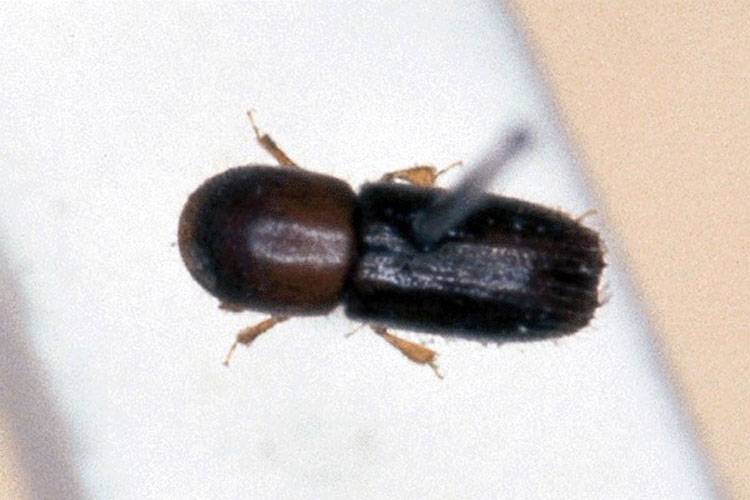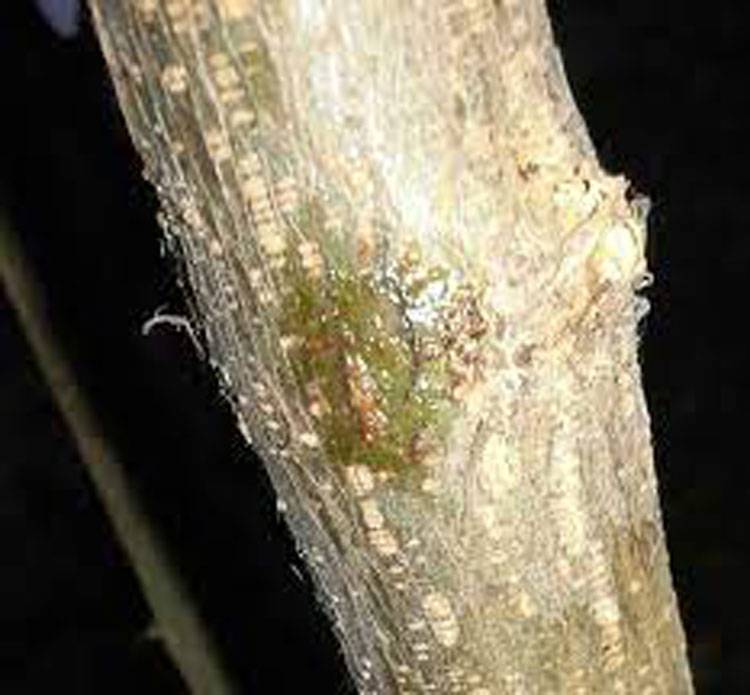Pomegranate
Shot hole borer

Shot hole borer
Xyleborus perforans

Shot hole borer
Xyleborus perforans

Shot hole borer
Xyleborus perforans
Shot Hole Borer (Xyleborus spp.) in Pomegranate
Seasonal Incidence and Life Cycle
- Active throughout the year, with peak activity during the monsoon.
- Adult females attack freshly dead or dying plants and can colonize healthy trees, causing mass accumulation and damage.
- Infestation is characterized by white dripping fluid from beetle entrance holes in pomegranate.
- Adult females create tunnels encircling the stem and branches, laying eggs in small clusters.
- Grubs pass through three instars, feeding on symbiotic ambrosia fungi in the galleries.
- Pupation occurs inside the communal gallery, and newly emerged females remain in galleries for several days before dispersing.
- Beetles transport symbiotic fungi, which cause cambial necrosis, exudates, branch dieback, and tree mortality.
Alternate Hosts
- Castor, tea, coffee, mango, guava, teak, and others.
Distribution
- A major pest of forest trees in India and abroad.
- Since 1981, it has become a significant pest of pomegranate in Maharashtra and Karnataka.
Hosts of Commercial Importance
- Punica granatum (pomegranate) recorded as a host in Maharashtra (Mote et al., 1991).
Identification
- Eggs: Shiny, oval/round, white.
- Larvae: White, apodous, up to 4 mm long.
- Adults: 2-3 mm long, reddish-brown to black, with capsule-like bodies and chewing mouthparts.
Biology
- Egg stage: 6.7 ± 0.3 days.
- Larval stage (three instars): 10.6 ± 0.5 days.
- Pupal stage: 7.3 ± 0.33 days.
- Adult lifespan: 18.10 ± 0.53 days.
- Sex ratio: 13:1 (female: male) (Kamala Jayanthi et al., 2020).
- Generations per year: Two.
Temperature and Humidity Influence
- Eggs: Laid in groups of 2-4 along tunnels; at 29°C, females lay eggs within 3-27 days (Roeper et al., 1980).
- Larvae: Hatch in 7–14 days at 29°C and 14–35 days at 22–24°C.
- Pupae: Development takes 11–23 days at 29°C and 21–35 days at 22–24°C.
- Adults: Emerge in 18–35 days at 29°C and 27–35 days at 22–24°C.
Mode of Feeding and Symptoms of Infestation
- Females bore into the basal part of stems and roots.
- Infestation begins with mild yellowing of lateral branches, leading to complete drying.
- Affected trees may bear heavily but produce undersized, immature fruits.
- Pinholes with or without frass appear on the trunk, often near the soil line.
- Subterranean (below soil) holes in roots indicate a shot hole borer attack.
Management Strategies
Cultural Methods
- Maintain proper plant spacing to avoid overcrowding.
- Prevent waterlogging; keep soil aerated.
- Uproot and burn infested trees to eliminate the pest.
Mechanical Methods
- Regular monitoring for drying branches to detect early infestation.
Biological Control
- Parasitoids: Trichogramma spp., Tetrastichus spp., Telenomus spp., Chelonus blackburni, Carcelia spp., Campoletis chlorideae, Bracon spp.
- Predators: Chrysoperla spp., rove beetles, spiders, parasitic wasps, coccinellids, Geocoris spp., pentatomid bugs (Eocanthecona fucellata), earwigs, ground beetles, common mynah, and king crow.
Preventive Measures
- Keep plants healthy with proper horticulture practices.
- Maintain weed-free fields to reduce nutrient competition.
- Avoid waterlogging; monitor drying branches after rainfall.
- Remove and destroy infested branches.
- Eliminate alternate hosts around pomegranate orchards.
- Avoid piling dead or uprooted wood near orchards.
- Install solar light traps (@ 1 trap/ha) with an automatic dusk switch.
- Preventive insecticide sprays: Emamectin benzoate 5% SG + Azadirachtin 10000 ppm @ 3ml/L, applied alternately at monthly/bi-monthly intervals.
- Preventative drenching: Emamectin benzoate 5% SG + Propiconazole 10% SC (2g/L + 2ml/L) after the first rain.
Stem Pasting (From the 2nd Year Onwards)
Apply paste before and after bahar (crop season) up to 2 ft from the base of the stem.
- Preparation (10L water mix):
- Red Soil: 4kg
- Emamectin Benzoate 5SG: 20ml
- Copper Oxychloride 50WP: 25g
Curative Measures
Drenching
- First drenching: Emamectin benzoate 5% SG + Propiconazole 10% SC (2g/L + 2ml/L water).
- Second drenching (15-20 days later): Emamectin benzoate 5% SG + Carbendazim 50% WP (2g + 1g/L) or Imidacloprid 17.8% SL + Carbendazim 50% WP (2ml + 2g/L).
- Third drenching (if needed, 15-20 days after second): Repeat first drenching chemicals.
Stem Spray
- Thiamethoxam 25% WG @ 1-2 ml/L + 0.5 ml spreader sticker/L.
- Followed by Azadirachtin 10000 ppm @ 3 ml/L + 0.5 ml spreader sticker/L.
Important Notes
- Irrigate plants well one day before treatment; stop irrigation for 3-5 days post-drenching.
- Avoid drenching during rainy days; repeat treatment if rain occurs within a day of application.
- Treatment sequence: Drenching → Stem spray → Stem pasting (completed within 1-2 days).
Source: ICAR, University of Florida
